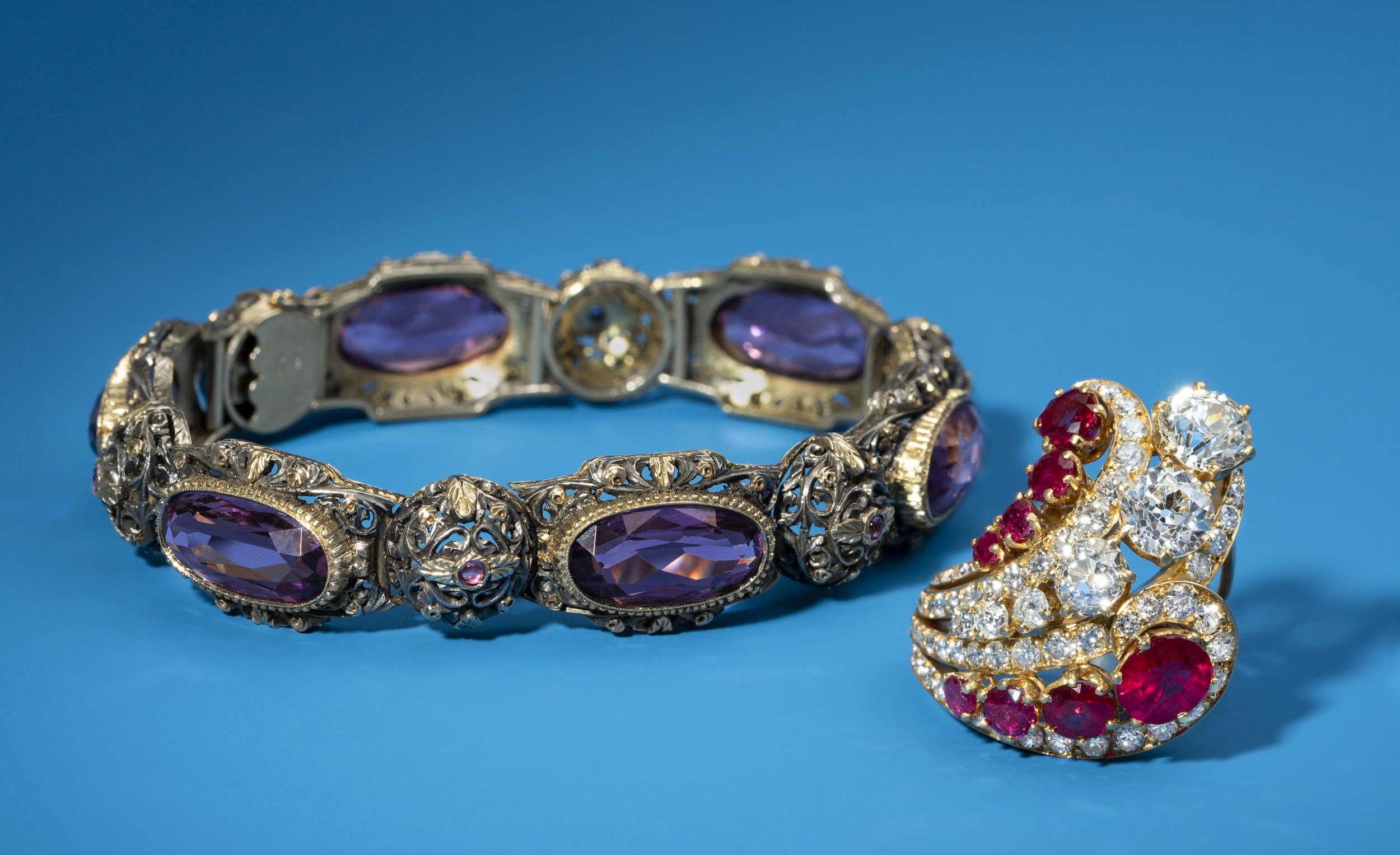Reveal the Rich History Behind Stunning Estate Fashion Jewelry Collections
The expedition of estate precious jewelry collections offers an unique window into history, disclosing the elaborate partnership between craftsmanship and social advancement (estate jewelry austin). Each piece is not simply a testament but an accessory to the imaginative activities and social worths of its time, from the elaborate details of the Victorian era to the streamlined elegance of the Mid-Century Modern. As we analyze these remarkable artifacts, we reveal tales that transcend generations, triggering us to consider not just their elegance, yet the lives they have actually touched and the moments they have actually observed. What keys might these collections still hold?
The Beginnings of Estate Fashion Jewelry
How did estate precious jewelry pertained to symbolize the abundant background and artistry of past ages? The origins of estate precious jewelry can be traced back to various durations of craftsmanship, where precious jewelry was not simply a device however a reflection of social values, technical developments, and imaginative expressions. Each item narrates, frequently linked with the lives of their previous owners, enveloping personal stories together with historic contexts.
The term "estate jewelry" normally describes used items, often from considerable ages such as Victorian, Art Nouveau, or Art Deco. These items were created with careful focus to detail, showcasing the skill of craftsmens that utilized materials like gold, silver, and valuable gems. Unlike modern fashion jewelry, estate items often feature special layouts that highlight the visual appeals of their time, therefore acting as substantial links to the past.

Noteworthy Design Eras
Throughout background, a number of significant style eras have considerably influenced the advancement of estate precious jewelry, each defined by distinct designs, products, and cultural contexts. The Georgian period (1714-1837) noted the beginning of intricate layouts, commonly including nature-inspired motifs and making use of products like gold, silver, and gemstones established in sophisticated settings. Following this, the Victorian period (1837-1901) presented romantic motifs, with emotional jewelry and cutting-edge methods such as using enamel and cameos.
The Art Nouveau duration (1890-1910) celebrated natural forms and the elegance of nature, using materials like opals and pearls in streaming designs. This was done well by the Art Deco age (1920-1939), which welcomed geometric patterns, strong shades, and extravagant materials such as platinum and rubies, reflecting the modernist spirit of the moment.
The Mid-Century Modern era (1940-1960) showcased streamlined layouts and making use of unusual materials, stressing minimalism and performance. Each of these periods not only shows the artistic motions of their time yet also envelops the social values and technical advancements that shaped precious jewelry design, making them an interesting topic for collection agencies and chroniclers alike.

Famous Estate Jewelry Collections
The rich background of estate precious jewelry is wonderfully exhibited by numerous renowned collections that showcase the virtuosity and workmanship from various style ages. Among the most renowned is the Cartier Collection, which shows the deluxe and development of the renowned French jewelry expert. Pieces from this collection frequently feature splendid gems and detailed layouts, highlighting the brand name's dedication to great craftsmanship.
Another noteworthy collection is the Duchess of Windsor's jewelry collection, which comprises a number of unique pieces, including the renowned "Windsor" bracelet. This collection not only exemplifies the elegance of the Art Deco duration yet additionally lugs an abundant story of love and loss, as it belonged to Wallis Simpson, who famously married Edward VIII.
The collection of the late starlet Elizabeth Taylor additionally attracts attention in the world of estate precious jewelry. With many items developed by popular jewelers like Bulgari and Cartier, her collection symbolizes glamour and sophistication, emphasizing her individual design and affinity for unique gemstones.
These renowned estate precious jewelry collections offer as a testament to the enduring attraction of great fashion jewelry, providing insight into the social their explanation and creative activities that formed their creation.
The Social Relevance
Estate fashion jewelry collections hold profound social relevance, reflecting not just the visual values of their corresponding ages but additionally the social and historic contexts in which they were created. Each item commonly symbolizes the craftsmanship why not check here and imaginative fads of its time, showcasing the development of design and modern technology in fashion jewelry making.
Furthermore, these collections work as substantial links to social customs and rituals. As an example, wedding bands and antique brooches might represent love and domestic bonds, while pieces embellished with particular gems can represent social or local identities. The materials utilized-- whether gold, silver, or priceless rocks-- typically inform stories of profession, expedition, and the riches build-up of cultures.
Additionally, estate fashion jewelry can operate as historic artifacts, offering understandings right into the lives of individuals and the societal norms they browsed. The means precious jewelry was worn and valued can expose much regarding sex duties, status, and personal expression within varying cultural landscapes. Estate precious jewelry goes beyond plain embellishment, acting as an abundant story of human experience, virtuosity, and social heritage, welcoming modern target markets to involve with the past in a significant method.
Caring for Your Estate Pieces
Caring for estate fashion jewelry pieces calls for a thoughtful strategy to ensure their longevity and maintain their special attributes. Always tidy estate fashion jewelry using a soft, lint-free towel after each wear to eliminate oils and dirt.
Storage space is similarly important; shop pieces separately in a fabric-lined box to stop entangling and scraping. Consider making use of anti-tarnish pouches or towels for silver products, as this helps to decrease the tarnishing procedure. Additionally, stay clear of subjecting jewelry to extreme moisture, severe temperatures, or straight sunlight, which can negatively affect gemstones and steels.
Consulting a jeweler experienced in vintage or antique pieces can give specialized care choices. By applying these practices, collection agencies can protect their estate precious jewelry's historical and aesthetic worth, making certain these items continue to be cherished for generations to come.
Final Thought
In verdict, the expedition of estate precious jewelry collections reveals a tapestry of artistic expression and cultural importance, showing the worths and aesthetics of various historical periods. Each piece serves as a testament to outstanding workmanship and the stories of those that as soon as possessed them. Comprehending the beginnings, style ages, and significant collections improves recognition for these artifacts, emphasizing their role in preserving cultural heritage and motivating ongoing stewardship and look after these amazing treasures.
The exploration of estate jewelry collections offers an unique home window right into background, exposing the elaborate relationship in between workmanship and cultural evolution. The origins of estate precious jewelry can be mapped back to different periods of workmanship, where precious jewelry was not simply an accessory but a representation of societal values, technical improvements, and creative expressions.The term "estate jewelry" typically refers to secondhand items, frequently from significant periods such as Victorian, Art Nouveau, or Art Deco.The rich background of estate fashion jewelry is wonderfully exhibited by a number of renowned collections that display the creativity and workmanship from different design periods.In final thought, the expedition of estate fashion jewelry collections here are the findings reveals a tapestry of creative expression and cultural value, showing the worths and aesthetic appeals of various historic durations.
 Hailie Jade Scott Mathers Then & Now!
Hailie Jade Scott Mathers Then & Now! Tiffany Trump Then & Now!
Tiffany Trump Then & Now! Heather Locklear Then & Now!
Heather Locklear Then & Now! Bernadette Peters Then & Now!
Bernadette Peters Then & Now! Meadow Walker Then & Now!
Meadow Walker Then & Now!